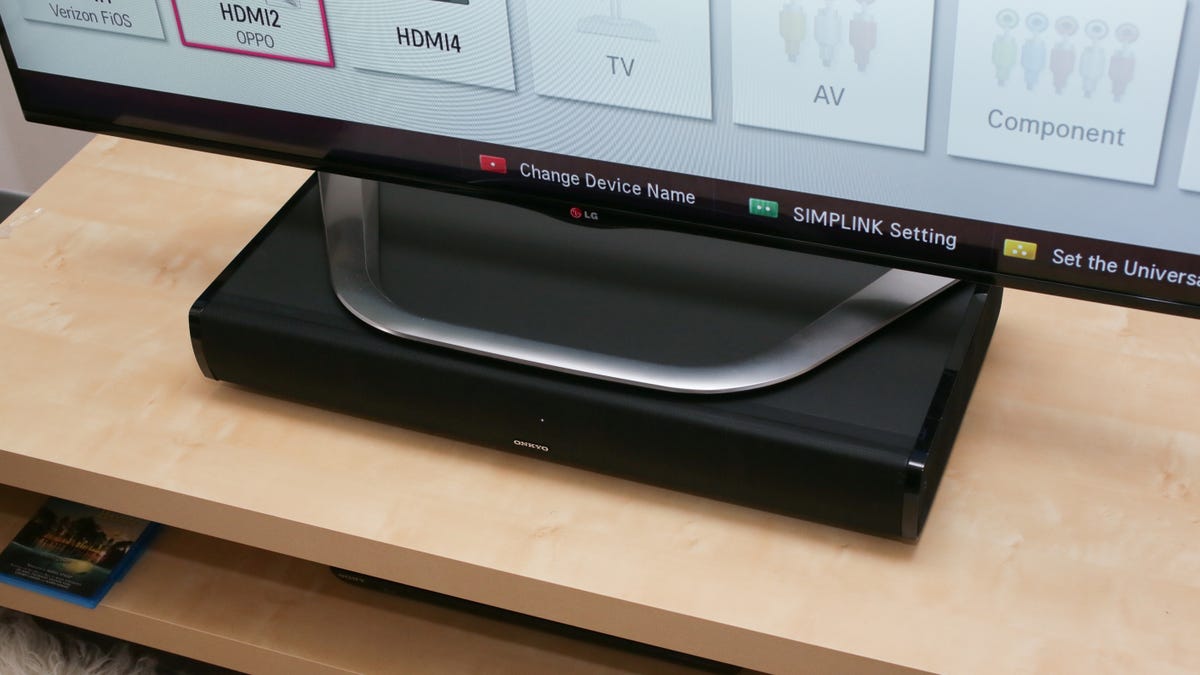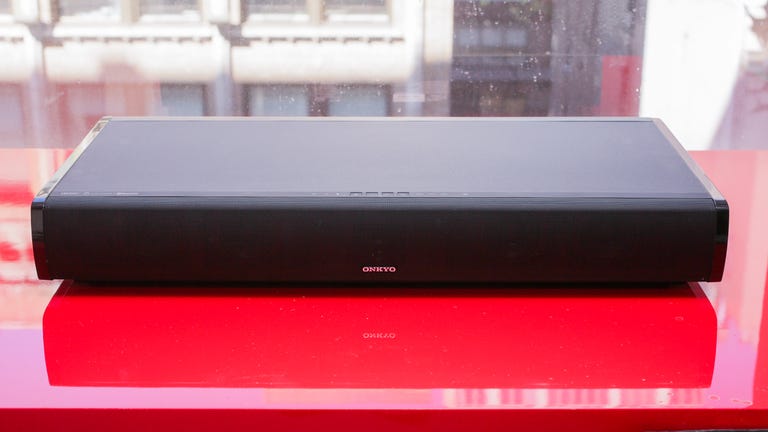 Why You Can Trust CNET
Why You Can Trust CNET Onkyo LS-T10 review: A sound stand strictly for cinephiles
The Onkyo LS-T10 sound stand feels well-built and sounds good with movies, but its poor performance with music makes it rough to recommend.
If you have a TV with a centrally-mounted stand and want to improve your sound quality, then a sound stand is sleek-looking option. All-in-one speakers like the Onkyo LS-T10 offer a single-cable connection from your TV and can be controlled by your TV's remote, making it easy to integrate into your existing living room setup.
The Good
The Bad
The Bottom Line
The Onkyo is well constructed and will support most TVs under 55 inches with ease. It offers a modicum of features -- some useful and some not -- and its price is fairly easy on the wallet. The big snag is that its sound quality is mixed. The LS-T10 is best with movies, offering clean dialogue and the built-in subwoofer adds grunt to special-effects-laden soundtracks. But music sound downright tinny and thin, even by the lowered standards of a sound stand or sound bar. Unless you don't care about music playback at all, you're best off checking out a more well-rounded sound stand like the Sony HT-XT1 or Speakercraft CS3 .
Design
Sound stands are reclusive creatures by nature, designed to disappear without ostentation at the bottom of the TVs they support. As expected, the LS-T10 is a large gray box with only the word "Onkyo" on the bottom to distinguish it from other models. It measures approximately 28 inches wide by 4 inches tall, and 14 inches deep.

The LS-T10's manual says it can accommodate TVs up to 77 pounds, and we'd recommend sticking to TVs of 55 inches and less. The Onkyo is substantially heavier and more solid-feeling than competitors like the Sony HT-XT1, however, and by omitting the glass top of the Sony, it might give prospective users a little more peace of mind about its stability.
On the top lip of the speaker there are a small number of controls, which include source, volume up and down, and sound mode. The front of the speaker lacks any type of display, but there are two small LEDs on top alongside the buttons to indicate source and sound mode. Unfortunately the LEDs aren't visible from a normal seating distance, so you won't get any visual feedback when making adjustments as you do on Zvox's speakers.
While the competing Sony HT-XT1 has a proper wand remote, the Onkyo opts for a dinky credit card-style model. All of the controls are there, including USB playback and a separate subwoofer volume control, but it's not all that ergonomically friendly -- especially in the dark. Luckily, you can program the LS-T10 to respond to your TV's remote control (although that does have its problems) or a universal remote instead.
Features
While Onkyo began life as a hi-fi company, it's now more readily known for its contribution to home cinema . The LS-T10 follows the latter philosophy, which is obvious from its speaker configuration. While stereo speakers for music are designed to fire directly at the listener, home-cinema speakers such as sound bars sometimes employ side-firing drivers. This is the case for the Onkyo, which has two side-firing woofers, in addition to four full-range drivers on the front, and an "active subwoofer" on the bottom.
Onkyo neglects to say what the power output is, other than the fact that it's driven by a "six-channel digital amplifier." Additionally, the speaker comes with three sound presets -- Movie, Music, and News -- and uses AuraSphere digital signal processing (DSP) to create "an all-enveloping 3D soundfield."
Most users can connect to their TV using the optical audio input, and the Onkyo also includes a coaxial digital jack and a 3.5mm analog audio input. Unfortunately, there is no switching between inputs; if the speaker detects a signal on the optical input, it defaults to that.
The LS-T10 also lets you play audio via Bluetooth or a USB port, for flash devices loaded with music files. However, based on my testing, there are three reasons you won't play files via USB : 1) It will only play songs in the root of the drive, with no folder support; 2) It will only play MP3s and associated playlists -- no AAC, FLAC, or the like; and 3) Without a display there is no way to search for the song you want, other than just pressing forward or rewind blindly.
Performance
When the much-anticipated Sonos PlayBar hit our testing labs last year, we were confused: here was a device from a music-first company that, while performing well with movies, couldn't play music to the standard expected. The Onkyo LS-T10 is in a similar boat: it does nicely with movies, but it's simply bad with music.
Of the three different DSP modes, I found that Music and Movies are very similar, with only a small bass boost in Music. In comparison, News just uses the front-firing woofers and not the sub, so it sounds thin with music.
Deciding against the weak-sounding News preset, I selected Music mode, which resulted in some unusual effects on some music. I compared the Onkyo directly to the Sony HT-XT1, and swapping from it to the Onkyo while listening to music was like switching over to a bad AM radio -- the sound became muffled and indistinct. Spoon's 60's-tinged "You Got Yr. Cherry Bomb" sounded weird via the Onkyo: the sonics were swampy, while one of the tambourines appeared to come out of the corner of the room, as if the percussionist was hiding there.
The speaker's sound signature has been described as "bassy," but give the music something with deep bass and it simply falls apart. "Life" by the Beta Band was almost unlistenable once the synth bass came in -- it was murky and lumpy, like thick minestrone.
The omission of an official power output rating is fairly telling, as it doesn't take long for the sound to get terribly shouty and harsh when turning up the volume. Unlike the Sony HT-XT1, it doesn't cut off at a "fail-safe" point, but lets you crank it ever louder, even if it's significantly distorted.
While the LS-T10 just doesn't cut it with music, it was the better of the two speakers when it came to movies. The Onkyo is suited to both male and female dialogue, and this was the case with the bridge scene from "Mission: Impossible III." Here, a motorcade taking Owen Davian (Philip Seymour Hoffman) is attacked as it crosses a bridge and features both explodey bits and quiet dialogue.
Whether it was the scratchy whispers of an agent's encoded message or Ving Rhames' booming baritone, the speaker was much more intelligible than the Sony. In addition, sound effects had extra weight, and explosions had more boom! While there was less tinkle of breaking glass on the Onkyo, it had a way of getting rid of extraneous sounds to let you hone in on dialogue. On the other hand, while the "wide" effect is quite pronounced on the Onkyo, don't expect true surround sound, as it never tricks you into believing sounds are coming from behind you.
Conclusion
If you're looking for a speaker that can make dialogue sound more intelligible than your TV, then the Onkyo LS-T10 is worth considering, and it can add weight to action movies as well. But its wimpy music performance is hard to swallow, even if you tend to stick with music and TV. When the Sony HT-XT1 costs less, includes HDMI connectivity, and has better overall performance, the LS-T10's shortcoming are hard to overlook.


